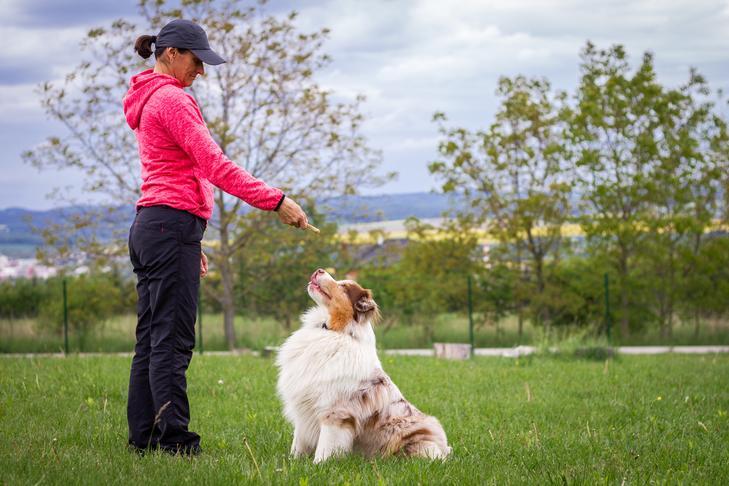Owning a dog isn’t just about cuddles, walks, and playing fetch – dog obedience training is a crucial component to having a healthy, happy, well-adjusted pooch. Training not only improves the connection between dog and owner but also significantly reduces the risk of behavioural issues down the track. It’s about teaching your dog how to navigate the human world – providing them with guidance, structure, and boundaries that are undoubtedly essential to their wellbeing.
However, as most dog parents can tell you, there will undeniably be bumps in the road. Barking, digging and occasional aggression can be part and parcel of the dog-owning experience, and the road to correction requires patience, persistence, and the right strategies.
Understanding Dog Psychology
Understanding a dog’s psychology is beneficial when undertaking obedience training. Dogs, like humans, have individual temperaments and personalities which significantly influence how they respond to their environment. Communication, for dogs, is fundamentally different from humans as it’s largely based on body language.
Understanding your dog’s breed is also crucial. Different breeds have distinct traits and behaviours ingrained through generations of careful selection. Recognising breed-specific behaviours will help set realistic expectations and tailor you’re training accordingly for better results.
The Role of Consistency in Training
Consistency is arguably the most vital element in successful dog training. It means maintaining a steady approach to the dog’s training sessions, commands and actions which ensures your dog quickly learns what is expected. For instance, if you give a command for an action today, use the same command for the same action tomorrow.
Communication is crucial in establishing consistency. Clarity in your instructions will create more accessible and quicker learning experiences for your dog. The more specific you can be with your instructions, the easier it will be for your dog to comprehend what’s expected.
Essential Obedience Training Strategies
Obedience training should start with fundamental commands such as sit, stay, come, and leave it. As your dog progresses in understanding these initial commands, you can then introduce advanced commands to enhance responsiveness and control. These could include commands like ‘heel’, ‘drop’, and ‘stay’ even amidst distractions.
Patience really is virtue here, as each dog learns at its own pace. You must ensure that your furry friend is completely comfortable with a command before moving onto the next.
Managing and Improving Behavioural Issues
Dogs may exhibit certain behavioural issues due to various reasons such as fear, anxiety, or because they’re seeking attention. Common problems include barking, digging, and lately aggression. Observing the pattern and frequency of such behaviours can help you deduce their cause, subsequently informing your method of correction.
For example, if your dog barks excessively to attract attention, a possible solution could be to ignore them until they stop barking. Addressing each behavioural issue needs to be specific and strategic to be effective.
Rewards-Based Dog Training
Reward-based training is a popular method that promises effective results. This method operates on the simple principle that behaviours followed by enjoyable consequences are likely to be repeated. Dog treats, praise, or playtimes make for popular rewards.
It’s essential to use rewards appropriately – the reward must immediately follow the desired behaviour for your dog to associate it with the action. Consistency, timing, and the right kind of reward are central to the success of this strategy.

Involving a Professional Dog Trainer
If you’re finding it challenging to rectify behavioural issues or if your dog is showing signs of serious aggression, it could be time to involve a professional dog trainer. Professionals are qualified to handle a range of behavioural problems and can significantly streamline the training process.
Choosing a good trainer, however, requires research. Make sure the trainer uses humane training methods, has experience handling your breed, and comes recommended by other dog owners.
Maintaining Progress and Consistency Outside of Training Sessions
Practicing obedience outside of structured training sessions is fundamental to maintain progress. If you only teach your dog to “sit” when you’re in training mode, they might not react to the command in other situations. Incorporating training cues in their daily routines rewires their behaviour pattern, making the trained action the default response.
You could do this by commanding your dog to “sit” before their meals or “stay” before you throw their favourite toy. The key here is to integrate training into fun, everyday activities.
Utilising Dog Obedience Training Tools
There are numerous dog training tools available that can help facilitate the process. Leashes and collars are fundamental, but there are other tools like clickers, target sticks, or even training apps that can make the process simpler and more effective.
Whatever tool you choose, make sure it’s safe and comfortable for your dog. Also, remember that tools are just aids – the crux of training rests in patience, persistence, and consistency.
Conclusion
Training a dog requires a measured balance of understanding, consistency, patience, and persistence. Understanding dog obedience training psychology is key, and consistency and patience are equally important. Behavioural issues can be resolved with the correct strategies, and there are plenty of tools available to help in the process. And remember, if ever you’re in doubt, don’t hesitate to seek the advice of a professional dog trainer.








